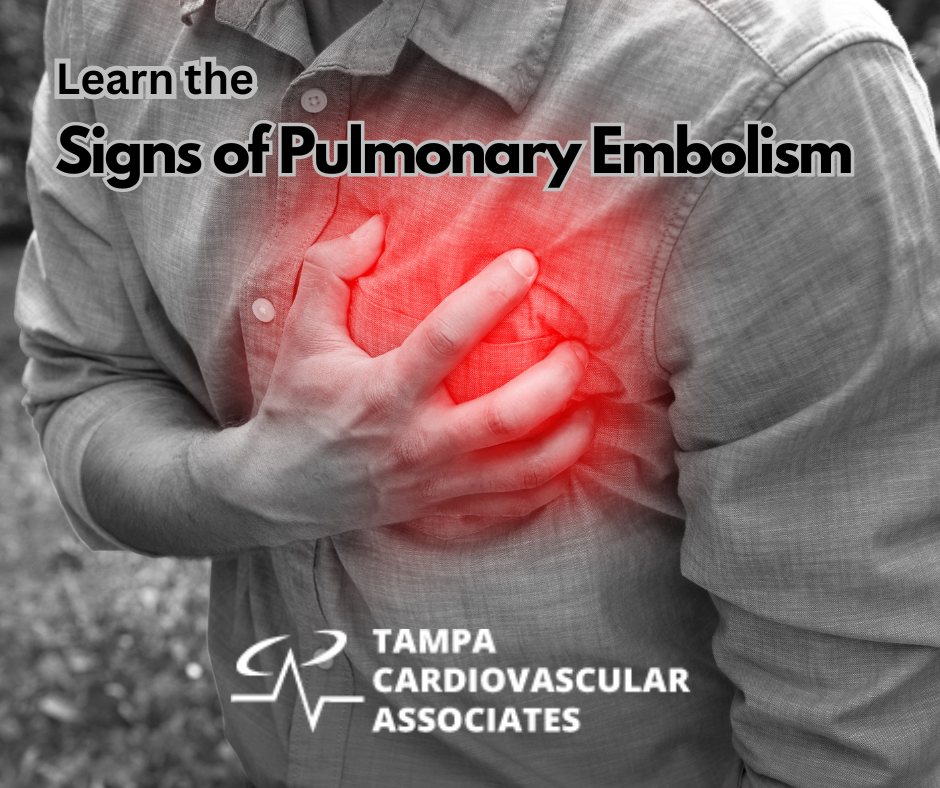Learn the Signs of a Pulmonary Embolism
Posted by: Tampa Cardio
On: February 8, 2024

Understanding the potential warning signs of a pulmonary embolism (PE) can be lifesaving, especially for vulnerable populations such as patients with heart issues and the elderly. In this detailed guide, we’ll explore the critical symptoms to watch for, and why immediate medical attention is crucial for a positive outcome.
Understanding Pulmonary Embolism
A pulmonary embolism is a blockage in one of the pulmonary arteries in your lungs, typically caused by blood clots that travel from the legs or other parts of the body. These clots can be deadly, obstructing blood flow to lung tissue, and in severe cases, causing collapse or heart failure.
Risk Factors and Demographics
Anyone can be affected by PE, but certain risk factors can increase the likelihood of its occurrence:
- Prolonged immobility (such as long flights or bed rest)
- Recent surgery, particularly hip or knee replacements
- History of deep vein thrombosis or blood clots
- Smoking
- Certain genetic conditions affecting blood clotting
- Chronic inflammatory diseases
- Obesity
- Hormone-based medications
Common Signs and Symptoms
The symptoms of a pulmonary embolism may vary depending on the size of the clot and an individual’s health, but common signs include:
- Chest Pain: Often sudden and may worsen with deep breathing.
- Shortness of Breath: An unexplained struggle to breathe could signal a PE.
- Coughing: Coughing that may produce bloody or blood-streaked sputum.
- Wheezing: A whistle-like sound while breathing out.
- Rapid Heartbeat: Noticeable pounding or racing of the heart.
- Lightheadedness: Feeling dizzy or faint.
Distinguishing Pulmonary Embolism from Other Conditions
Pulmonary embolism can often be confused with other conditions like heart attacks or pneumonia due to similarity in symptoms. For instance, chest pain and shortness of breath are common in heart attacks, while coughing is more associated with pneumonia. However, the sudden onset and combination of the above symptoms tend to suggest a PE.
When to Seek Medical Attention
If you suspect that you or someone you know might have a PE, seek emergency medical help immediately. PE can lead to serious complications, including heart strain and sudden death.
Prevention and Treatment
While PEs can be dangerous, they are also largely preventable and treatable:
- Lifestyle changes such as quitting smoking, losing weight, and exercising can be beneficial.
- Medications like anticoagulants help prevent clots.
- In severe cases, medical procedures, such as clot removal or the insertion of filters to the veins, may be necessary.
It is essential to follow your healthcare provider’s advice on prevention strategies if you have risk factors for PE.
Staying Informed
Staying informed about the signs and symptoms of pulmonary embolism is a must. A quick response in seeking medical aid not only improves chances of survival but also mitigates the risk of long-term complications. We encourage individuals, particularly those at higher risk, to converse with their healthcare providers about PE risks and to pursue prompt attention if PE symptoms arise.
Your health and well-being deserve to be safeguarded. Work with the doctors at Tampa Cardio. www.Tampacardio.com 813-975-2800.
Posted by: Tampa Cardio
On: 08/02/2024
